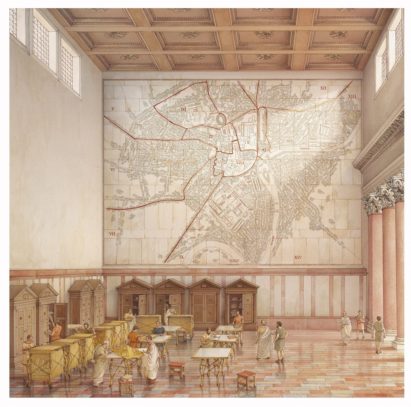Between the years 70-75 A.D., following the civil war for succession to the empire and after the bloody repression of the Jewish revolt, the emperor Vespasian (69-79 A.D.) built a shrine dedicated to the Peace. The shrine was called “Temple of the Peace” (in latin: Templum Pacis) or “Forum of the Peace”. It was composed by a large porticoed square with a temple at the end, flanked by two halls.

The complex became an integral part of the five Imperial Fora, being the third in chronological order after the Forums of Caesar (46 B.C.) and Augustus (2 B.C.) and constructed prior to those of Nerva (97 A.D.) and Trajan (112-113 A.D.). It differed profoundly from these complexes because of its function. The Imperial Fora were mainly used for the administration of justice as a court, in addition to a place of libraries and legal archives.
In contrast, the Forum of the Peace hosted a rich collection of sculptures and paintings, along with a famous scientific and literary library (the Bibliotheca Pacis) making this area as a “cultural centre” adorned with creations of the human mind.

In a hall next to the temple, was the famous large marble plan of the ancient Rome, known as the “Forma Urbis Romae”. It was positioned (12 x 18 meters). It was positioned on a wall still preserved as the actual facade of the church of the Saints Cosmas and Damian.
Between 1998-2000, the Municipal Department of Monuments and Cultural Heritage undertook an extensive project of archaeological excavation whereby the north-west area of the ancient square was discovered together with the pink granite shafts from Aswan (Egypt), which supported the magnificent portico comprising Corinthian columns covered by a roof with white marble tiles.
